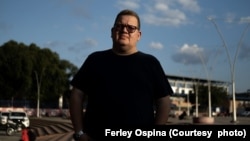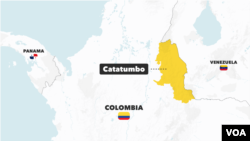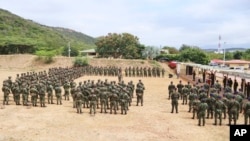In a vehicle with his two bodyguards, Cristian Herrera talks about the dangers he faces covering Colombia’s Catatumbo region as he heads to his latest assignment.
An independent reporter, Herrera has always worked in this region, the Norte de Santander department. His beat includes coverage of robberies, extortions, kidnappings, corruption, drug trafficking, criminal gangs and illegal armed groups.
Since 2014 those assignments have come with a security detail, a necessary addition after constant threats. “They call me, they send me voice messages, they leave pamphlets or people tell me,” Herrera says.
The latest — a voicemail on his phone — said: “I’m looking for a reporter with a big tongue. We’ll have to cut his tongue.”
Often, it is hard to tell who is making the threat.
“We cover so many stories that I don’t know who it is from,” Herrera says.
Coverage of the region has always brought risks. As well as illegal armed groups, he tells VOA, “There is drug trafficking; there are coca crops, coca leaf crops; there are cocaine labs.”
Added to those dangers is a flare up in clashes between two rival armed groups: the National Liberation Army and a group known the Central General Staff (Estado Mayor Central-EMC), a group of dissidents from the guerilla Revolutionary Armed Forces of Colombia, or FARC.
The fighting has left more than 56 people dead and more than 54,000 displaced, according to figures released this month by the Norte de Santander government.
But just as residents in this region of more than 194,000 need access to news about the fighting, it is becoming harder for media to report safely.
The regional media freedom group Fundacion para la Libertad de Prensa, or FLIP, warns that the Catatumbo region conflict silences local reporters.
“The situation in Catatumbo is critical, as it is in the entire department of northern Santander, which unfortunately is becoming the most dangerous place to practice journalism in the country,” Jonathan Bock Ruiz, executive director of FLIP, tells VOA.
Few reporters inside the region are able to report about the violence, and for those who live near or in Catatumbo, coverage is extremely dangerous.
“I think as reporters, we are just receiving information of 20% of what is happening,” says Herrera.
Journalists 'can't talk about anything'
Colombia overall has been improving in media freedom rankings, with a 20-point improvement on the World Press Freedom Index. But it is also still considered one of the riskiest countries for journalists.
And one of the most dangerous regions is Catatumbo. Two journalists were killed there last year.
On the border with Venezuela, the Catatumbo region is just under 300 kilometers from Cucuta, the capital of Norte de Santander. With numerous national resources and a key coca leaf production region, it has long been a base for criminal groups, paramilitaries and guerrillas.
Before FARC demobilized in a peace accord in 2016, militants controlled who gained access. Now things are different. “You don’t know who’s in charge,” says Herrera. “There are some organizations that are mixed with migrants who are used as instruments to commit crimes.
“Furthermore, it is an area that has been very abandoned by the state, and so those who exercise control in this region are these illegal armed groups,” he says.
Often the safest option is to stay quiet.
“[Journalists] can’t talk about the armed conflict, what happens there. They can’t talk about the deaths. They can't talk about drug trafficking. They can't talk about anything," Herrera tells VOA.
'You have to publish it'
Another problem comes from guerrillas or criminal groups that coerce media to serve as spokespersons — and saying “no” is not an option.
“There is a very serious collective problem, information is used as a weapon of war, as a weapon to make propaganda, to better install the narratives of the different groups, as a way of citizen control,” says Ruiz.
Herrera says the media strategy of illegal armed groups is to spread information through social media.
“It happens in El Catatumbo and in Cucuta, illegal armed groups have a digital strategy. They send their messages and start sharing them through social media; they send it to us, and sometimes with threats,” he says. “They say, ‘You have to publish it,’ and if you say no, they declare you as a military target.”
The combination of physical risk, self-censorship and control by armed groups leaves audiences with limited access to independent news.
“This has already happened in the Catatumbo at different times, where community journalists decide to turn off their radio stations. They decide to stop reporting ... where self-protection protocols are not enough to do their work safely with the number of threats and the lack of protection given by the state,” explains Ruiz.
In his 20-year career, Herrera has come up against multiple threats, including three kidnap attempts. At times, he left Colombia to ensure his safety.
So, security is a priority. “If I’m going to the Catatumbo, I advise FLIP and my wife, I must check in every two hours, and if five hours pass and I haven’t texted her, something has happened,” he says.
Despite the dangers, Herrera said he will not stop reporting.
“All the risks and threats give me more strength to keep going, because that shows that I am doing things right,” he says.








